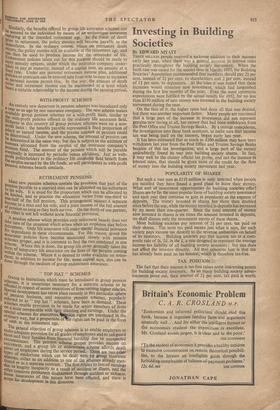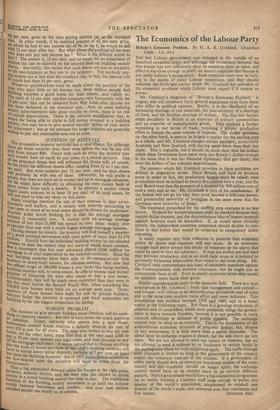Investing in Building Societies
By EDWARD MYATT THREE MILLION people received a welcome addition to their incomes early last year, when there was a general increase in interest rates practically throughout the building society movement. When the bank rate was raised for the second time in March, 1952, the Building Societies' Association recommended that members should pay 21 per cent. instead of 21 per cent. to shareholders and 2 per cent. instead of 11 per cent. to depositors. At the time it was hoped that these increases would stimulate new investment, which had languished during the first few months of the year. Even the most optimistic expectations were fulfilled by the actual results for 1952, for no less than £110 million of new money was invested in the building society movement during the year. On the face of it, the higher rates had done all that was desired, but there was another important factor. Many people are convinced that a large part of the increase in investment did not represent genuine new saving at all, but money that had been withdrawn from the Post Office and Trustee Savings Banks. By a strange coincidence, the investigation into these bank accounts, to make sure that income tax was being paid on the interest, began early last year. It has been estimated that as much as £100 million may have been withdrawn last year from the Post Office and Trustee Savings Banks because of this tax investigation; and a large part of the money undoubtedly found its way into building society shares. In fact, it may well be the clumsy official tax probe, and not the increase in interest rates, that should be given most of the credit for the flow of money into the building society movement last year.
POPULARITY OF SHARES But such a vast sum as £110 million is only invested when people are satisfied they have found a good place to leave their money. What sort of investment opportunities do building societies offer? Shares are by far the most popular form of building society investment and each year they continue to gain in popularity at the expense of deposits. The money invested in shares has more than doubled since before the war, while the money inyested in deposits has increased by no more than one-quarter. Since the total amount of money now invested in shares is six times the amount invested in deposits, we shall discuss only the investment merits of these shares. Most building societies pay interest of 21 per cent. tax paid on their shares. The term tax paid means just what it says, for each society pays income tax directly to the revenue authorities on behalf of its investors. Building societies pay this income tax at a com- posite rate of 5s. 2d. in the £, a rate designed to represent the average income tax liability of all building society investors ; but this does not affect the investor directly. All that concerns him is that tax has already been paid on his interest, which is therefore tax-free.
TAX POSITION The fact that their interest is tax-free raises some interesting points for building society investors.. As so many building society adver- tisements point out, their interest of 21 per cent. tax paid is worth 44 Per cent. gross to the man paying income tax at the standard rate. In other words, if he received interest of 44 per cent, gross, on which he had to pay income tax of 9s. in the £, he would be left With 24 per cent. after tax. But what about the position of the man Who does not pay any income tax ? What is the interest worth to him ? The answer is, 24 per cent. and no more, for no repayment of Income tax can be claimed on the interest paid on building society shares. Inevitably, this means that such shares are not so attractive to the non-taxpayer as they are to the taxpayer. For anybody pay- Ling income tax at less than the standard rate, in fact, the interest will be worth less than 44 per cent. gross. Whatever qualifications must be made about the position of the ,Man who pays little or no income tax, three million people find building societies a good home for their money, and rightly so. .,t The e Yield of 24 per cent. tax-free compares very favourably with the t Per cent. that can be obtained from War Loan after income tax Has been deducted at the standard rate. And, as most building society advertisements take great trouble to stress, there is no risk of capital depreciation. There is the obvious qualification that, in return for being able to claim in full money invested in a building society, you may have to give several months' notice of your desire for repayment ; but at the moment the larger societies are generally willing to pay any reasonable sum out at once.
QUESTION OF RESERVES . The prospective investor certainly has a wide Choice, for although there are fewer societies than there were before the war he can still Pick from almost 800. Faced with such an array the investor may well wonder how on earth he can come to a sound decision. One of the principal things that will influence his choice will, of course, be the yields the different shares offer, ranging from 21 to 3 per cent. will Paid. But most societies pay 24 per cent., and his final choice will Probably lie with one of these. Obviously, he will prefer a !society that does not have all its money tied up in mortgage advances, ',,?' lie might have difficulty in obtaining his own money back at short notice from such a society. If he chooses a society whose will assets amount to at least 10 per cent. of its total assets,' he w'Ll not need to lose any sleep on this score. : 'luny societies mention the size of their reserves in their adver- ‘jsements and leaflets, and a society with reserves amounting to ;Per cent, or more of its total assets should be chosen for preference. ,ilother point worth looking for is that the average mortgage 2a,lance is reasonably low. A society with an average mortage balance of less than £1,000 has spread its risks more widely over properties than one with a much higher average mortgage balance. _Having chosen his society, the investor will find himself a member IT. la great national movement with total assets of more than £1,470 lion. Exactly how the individual building society he has selected chooses to lend the money may not seem of much direct concern. 13 lit a movement that last year advanced almost £268 million on mortgage is of vital importance to the national economy. Since the business building societies have been able to do comparatively little the in newly-built houses, for obvious reasons. But now that building target of 300,000 houses a year looks like being reached, ding societies will, to some extent, be able to resume their former practice of financing the man who wants to buy a new house. niortunately, they will be much more restricted than they were in 1,,n_s five years before the Second World War, when something like 7,000 new houses were built on an average each year. Three- 9.arters of those houses were built for sale by private builders, _blutlereas today the position is reversed and local authorities are building by far the biggest proportion for letting.
SUBSIDY PROBLEM ,,_ The decision to give private builders more freedom will do some- 'lung to improve matters. But this in turn raises the vexed question Pt- subsidies. Today, anybody who moves into a new three- bedroomed council house receives a subsidy towards his rent of over E35 a year for 60 years. The man who wishes to buy his own house, on the other hand, must first find at the very least £200 to NY , 10 per cent. deposit and legal costs, and then proceed to pay his mortgage each year. It seems agreed that to financeanything like the scale of house-purchase of the 1930's building societies will have to accept lower initial deposits, perhaps of 5 per cent. or less ; ID_ ut since the Building Societies' Act of 1939 placektevere restrictions " low-deposit sales the initiative will have to come from the Government. , That a big unsatisfied demand exists for houses at the right price, however, nobody doubts, and the man who has chosen to invest Money in a sound building society has little to fear. The traditional function of the building society movement is to hold the balance evenly betwe.en borrowers and lenders ; and over four million satisfied people can testify to its success.



















































 Previous page
Previous page